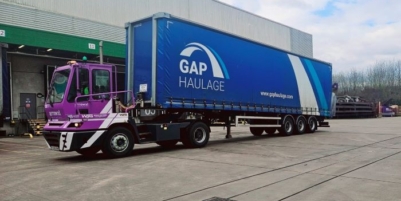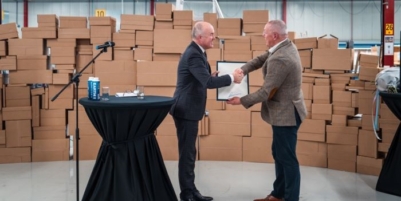-
Nutrivend selects Forterro’s Orderwise to support online expansion and streamline operations - April 11, 2025
-
ARROWXL LAUNCHES AMBITIOUS ZERO WASTE ROADMAP - April 8, 2025
-
THE BCMPA’S NEW CAMPAIGN DRIVES OUTSOURCING SUCCESS IN Q1 - April 7, 2025
-
BLACKOUT TECHNOLOGIES TARGETS TELEMATICS-INTEGRATED MOBILE DEVICE BLOCKING TO COMBAT SMARTPHONE DISTRACTION - April 1, 2025
-
Sparck Technologies awarded Royal designation - March 27, 2025
-
OpenADR Alliance announces first OpenADR 3.0 certified products with EVoke Systems, E.ON Energy and Universal Devices - March 25, 2025
-
Growing fulfilment and contract packer appoints new Managing Director - March 25, 2025
-
When is it time to invest in a WMS? Understanding the key trigger points - March 25, 2025
-
eCapital helps Vantage Recruitment on its journey to financial success - March 24, 2025
-
Hugo Beck Celebrates 70 Years of Packaging Innovation with Open House Events - March 20, 2025
Can warehouse automation advance sustainability? Dan Migliozzi, Head of Sales at independent systems integrator, Invar Group, looks at the options available.
Logistics and supply chain professionals are increasingly concerned about the sustainability of their operations, and in particular, about the environmental performance of their warehouses and DCs. What’s more, they have to be. Their customers are demanding ever greater and more demonstrable levels of sustainability.
This applies across the board, from how their facilities are constructed, to impacts on land use, hydrology and infrastructure requirements, transport movements generated, and of course how the facility itself is equipped and operated. As labour becomes scarcer, many businesses are considering automating warehouse processes. So, a big question for a growing number of companies is, can automation be used to advance sustainability within the warehouse?
Applied appropriately, higher levels of automation should lead to greater efficiency, less waste – including but not confined to fuel and energy – and therefore a more sustainable operation. In practice, things are not quite so clear-cut. Automation that is poorly thought out, mis-directed, inappropriately scaled, or implemented with substandard equipment, can impact both operational and environmental performance. However, a well-planned and implemented automation project can yield many sustainability benefits.
A big question is, should the automation be housed in an existing building, or is a new build designed around the requirements of automation a more sustainable solution?
A new build obviously generates a lot of carbon and uses other resources in its materials and construction. Also, a greenfield site will almost certainly impact the ‘natural’ environment, may influence drainage and groundwater and requires new infrastructure. But a new build can be designed to accommodate sustainability features such as solar panels, heat pumps, wind turbines, energy-conserving doorways, airlocks and insulation.
However, automation in an existing building may make better use of space, removing the need for physical expansion or any need to move. Exactly which option works best is a complex equation and depends on the long-term strategy of the business.
Whether in a new build or refurbished premises, automation can create many other sustainability benefits beyond the walls of the shed. More accurate and timely order fulfilment can reduce the size of truck park required – fewer acres under concrete. And to the extent that headcount is reduced, that is fewer staff bringing in and parking private vehicles.
Automation can lend itself to, at least partial, ‘lights out’ operation, if appropriate, saving considerable cost and energy. Incorporating a sophisticated Building Management System which optimises the needs of manual and automated operation can yield real cost and sustainability benefits.
So, what are the sustainability issues to consider when selecting the technology? Sourcing/procurement is one area to take up with the vendor or integrator. Are machines and materials traceable to suppliers with acceptable records on their own sustainability? How much power is consumed per unit of output? Does the design of the automated system minimise the number of motors in use? Is the most energy efficient technology being considered? Could gravity be put to good use? Do control systems allow lower power consumption at times of light usage? What recharging facilities and procedures are used for Autonomous Mobile Robots (AMRs) or other electric powered vehicles?
Unpowered elements also matter. Do conveyor components have the lowest coefficient of friction? This can make a huge difference – we know an installation where low friction belts saved 65% of power consumption which, given there were seven miles of conveyor, amounted to 20% of the consumption of the whole building.
Reputable integrators and vendors should supply reliable estimates of energy consumption, related to levels of usage as part of the bidding process. They should also detail their approach to SCADA (Supervisory Control And Data Acquisition) or other approaches to monitoring energy use as part of the control system for the automation. In use, this should be able to highlight areas where power consumption is high, perhaps pointing to a need for better equipment or different modes of operation.
This approach may also uncover areas where performance is deteriorating. Vendor equipment comes with detailed Preventative Maintenance schedules for good reason – it isn’t just a ploy to ramp up spare parts sales – which, incidentally, should always be authentic parts even if they are more costly. Without proper maintenance, performance will inevitably deteriorate, and sustainability will diminish, quite possibly ending with an expensive line stoppage.
Taken all together, the potential for automation to deliver real sustainability, as well as economic gains, is clearly evident.
Further independent advice on transforming operational performance in the warehouse can be found at: www.Invargroup.com
































